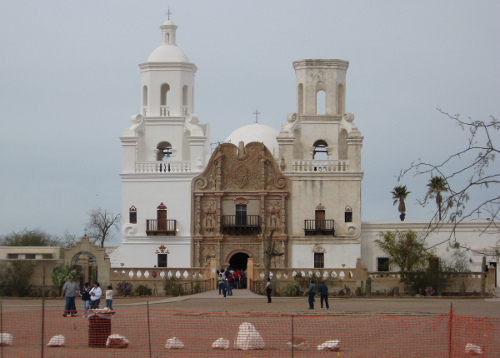Overview of Human Geography

Mission San Xavier del Bac, near Tucson, AZ: an example of a cultural landscape.
photo from Flickr/acsumama
About this Textbook [link]
In the fall of 2009, I was assigned to teach several sections of G&ES 100: Discover Geography at Slippery Rock University. In order to save my students some money in the midst of a severe economic downturn, I decided to use a combination of online and electronic reserve readings in lieu of a textbook. This project was made much easier by the existence of Michael Pidwirny’s Fundamentals of Physical Geography e-textbook. Human and human-environment geography, on the other hand, were rather more difficult to locate appropriate readings for. As the syllabus deadline approached, I ended up using several readings (notably for Gender and for Resources) that I didn’t find satisfactory. Were human and human-environment geography not my specialty, I would have been even more at a loss.
The aim of this e-textbook is to do for human and human-environment geography what Pidwirny’s text did for physical geography. Human geography is a much less settled field than physical, and so this text will necessarily reflect many of my own biases and pet areas of interest. In particular, the text and examples are United States-centric, as that is the position that I as an author, and the students I am using this book to teach, am in. Nevertheless, I hope that it will be useful to other teachers seeking to introduce students to basic concepts in human and human-environment geography.
In order to model good citation practice, I have endeavored to give in-text references for most of the claims in this book. At the same time, I have tried to maintain a balance of readability by limiting citations to one, or occasionally two, for each major idea, rather than giving an extensive literature review. References attempt to indicate works that are foundational, recent effective summaries, clear expositions, useful sources of further reading, and/or available online. The cited works may thus not match in detail the synthesis of ideas presented in the text. I always welcome feedback from experts in particular areas on the substance of my presentation as well as better citations.
This text is licensed under the Creative Commons Attribution-NonCommercial license. This means it, as well as all figures and maps not licensed from elsewhere, is free for any nonprofit or not-for-profit educational institution to use, as long as credit is given to the authors.
Contents [link]
Introduction
People and Identity
- Population
- Migration
- Cultural Landscapes
- Disability
- Race and Ethnicity
- Gender and Sexuality
- Age and Ageing
Human Systems
Society and the Environment
- Adaptation
- Resources
- Sustainable Development
- Environmental Management
- Risks and Vulnerability
- Agriculture
- Environmental Justice
- Environmental Perception
About the Author [link]
This text is written and maintained by Stentor Danielson, an Assistant Professor in the Department of Geography, Geology, and the Environment at Slippery Rock University of Pennsylvania. All opinions expressed in this text are those of the author and are not necessarily endorsed or shared by Slippery Rock University, the Pennsylvania State System of Higher Education, or any other institution or person with which the author is affiliated in any way. The author can be reached at stentor.danielson@sru.edu.